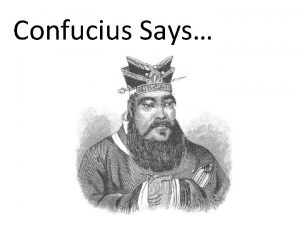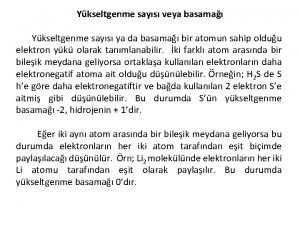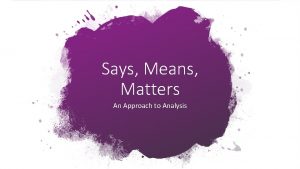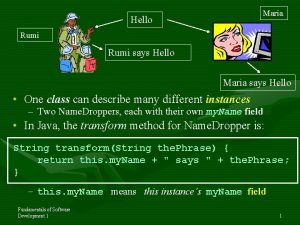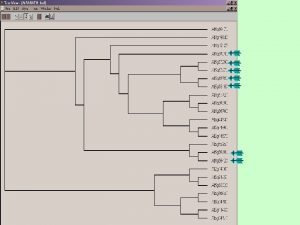The Identity Theory The Identity Theory says that






































![Objection 1 1. My pain [a mental state] is in my foot. 2. No Objection 1 1. My pain [a mental state] is in my foot. 2. No](https://slidetodoc.com/presentation_image_h2/4daf8c80b5dd695469ea438a3713712e/image-39.jpg)













- Slides: 52

The Identity Theory

The Identity Theory says that mental states are physical states of the brain. Cf. Property dualism, which says they are nonphysical states of the brain.

Clarification The Identity Theory says that all mental states are brain states. It does not say that all brain states are mental states. We might characterize it: certain brain states are mental states.

Brain States Mental States

More Specific Claims Conscious visual perception = high levels of neural activity in V 1. Experience of pain = C-fibers firing. Type of mental state = type of brain state.

J. J. C. Smart is one of the best-known 20 th Century identity theorists. At the beginning of his career he was a behaviorist, but later defended the Identity Theory.

Smart’s Analogy For Smart, the claim Mental states are brain states. was a lot like the claims: Water is H 2 O. Lightining is an electrical discharge.

Smart’s Analogy These identities are: • Not obvious • Not easily discovered • Not part of the meanings of the words (Compare “Bachelors are unmarried men, ” or “Hens are female chickens. ”)

Type vs. Token

Type vs. Token

Examples • “Scientists have discovered a 10, 000 year old fish. ” • “Dinosaurs are extinct. ” • “I have hundreds of foreign coins. ”

Types and Properties Standardly, types and properties are considered to be the same thing. The type dog = the property of being a dog. Tokens of a type are specific instances: things that have those properties.

Type Identity Theory Type identity theory claims that mental properties (mental states) are identical to properties of brains (brain states). The property of being water = the property of being H 2 O. The property of being a mental state = the property of being (certain) brain states.

Token Identity Theory (Token identity theory is more difficult to understand. We’ll talk about it next time. )

ARGUMENTS FOR THE IDENTITY THEORY

1. MSs Caused by States of the World According to the Identity Theorist, the fact that mental states are caused by states of the world is the same fact as the fact that brain states are caused by states of the world.





2. Some MSs Cause Actions For the Identity Theorist, this is the same as the claim that certain brain states cause actions. Again, the evidence for this is very strong.


Some MSs Cause Other MSs (In Reason-Respecting Ways) We can tell from what we’ve already seen that brain states cause other brain states. But can the identity theorist explain why these processes are rational/ logical?

EVIDENCE FROM DEFICIT STUDIES

Phineas Gage


From Ravenscroft

• While he was recovering, his family says he amused his nieces and nephews by making up fun stories. • A doctor did say he was changed– while he was recovering. But he said he was fine afterward. • He did lose his job– because his old employer wouldn’t take him back when he was better.

• Later in his life a doctor said Gage experienced ‘no impairment whatsoever. ’ • Gage did die early– but that’s because he experienced severe brain trauma. • No credible report says that he was an alcoholic or irresponsible.


Expressive Aphasia Broca’s aphasia (expressive aphasia) results from damage to Broca’s area. Here, patients can understand language perfectly, but can’t produce it. Here’s one patient explaining why he was at the hospital: “Yes. . . ah. . . Monday. . . er. . . Dad and Peter H. . . (his own name), and Dad. . er. . . hospital. . . and ah. . . Wednesday, nine o'clock. . . and oh. . . Thursday. . . ten o'clock, ah doctors. . . two. . . and doctors. . . and er. . . teeth. . . yah. ”

Video Time! http: //www. youtube. com/watch? v=1 apl. Tv. EQ 6 e w

ARGUMENTS AGAINST THE IDENTITY THEORY

Leibniz’s Law Also known as “the indiscernibility of identicals” If X = Y, then X and Y have all the same properties. [Converse] If X and Y don’t have all the same properties, then X ≠ Y.

Example Property: drives a motorcycle 1. Sally = the tallest person in the room. 2. Sally drives a motorcycle. 3. Therefore, the tallest person in the room drives a motorcycle.

Example Property: being red 1. My car is red (has the property of being red. 2. That car is not red (does not have the property). 3. Since my car and that car don’t have all the same properties, that car is not my car.

Type Example Property: boils at 100 degrees Celsius. 1. Water = H 2 O. 2. Water boils at 100 degrees Celsius. 3. Therefore, H 2 O boils at 100 degrees Celsius.

Schema of Objection to Identity Theory 1. Mental state S has property P. 2. No brain state has property P. 3. Therefore mental state S is not a brain state.
![Objection 1 1 My pain a mental state is in my foot 2 No Objection 1 1. My pain [a mental state] is in my foot. 2. No](https://slidetodoc.com/presentation_image_h2/4daf8c80b5dd695469ea438a3713712e/image-39.jpg)
Objection 1 1. My pain [a mental state] is in my foot. 2. No brain state is in my foot. 3. Therefore, my pain is not any brain state.

Response You have no pain in your foot. You have a brain state that registers or represents a state of your foot. This is why you can feel a pain in your foot even when you have no foot (phantom pain).

Objection 2 1. Activity in V 1 has a frequency. 2. My visual sensation of red does not have a frequency. 3. Therefore, activity in V 1 is not my visual sensation of red.

Neuronal Frequency

Response How do you know that? Science has discovered that your sensation of red does have a frequency. Science discovers new and interesting things all the time.

Final LL Objection 1. My pain hurts. 2. My brain don’t hurt. 3. Therefore, pain ain’t brain.

“Multiple Realizability”

Mental Multiple Realizability

Argument from M. R. If souls, squid, aliens, and robots can all feel pain, then pain can’t be a brain state, because these things don’t have brains. Maybe all human pains are brain states, but being a mental state type is not the same thing as being a brain state type.

Dualism Doesn’t Follow Mental states are multiply realizable, and so can’t be type-identified with brain states. Does that mean that the mind is not the brain? No. Having $5 is multiply realizable, and can’t be identified with having a coin like this one in my pocket. But right now the coin in my pocket is the $5 I have.

Reductive & Nonreductive Physicalism One way to maintain physicalism is to say that whenever you have a mental state, it is in fact (token identical) to a physical state. BUT, there’s no particular physical state a thing has to have to be that mental state. And maybe even a non-physical thing could have that mental state (there just aren’t any such things).

SUMMARY

• The Identity Theory says that mental states and certain brain states are type-identical. • The theory is consistent with physics and explains the causal interactions between mind and world (maybe not rationality). • A principal objection to theory is the apparent multiple realizability of mental states.

Functionalism What does a token-identity physicalist theory look like? We’ll find out next time!
 Phân độ lown
Phân độ lown Premature atrial contraction
Premature atrial contraction Thơ thất ngôn tứ tuyệt đường luật
Thơ thất ngôn tứ tuyệt đường luật Thơ thất ngôn tứ tuyệt đường luật
Thơ thất ngôn tứ tuyệt đường luật Chiến lược kinh doanh quốc tế của walmart
Chiến lược kinh doanh quốc tế của walmart Tìm vết của đường thẳng
Tìm vết của đường thẳng Con hãy đưa tay khi thấy người vấp ngã
Con hãy đưa tay khi thấy người vấp ngã Tôn thất thuyết là ai
Tôn thất thuyết là ai Gây tê cơ vuông thắt lưng
Gây tê cơ vuông thắt lưng Sau thất bại ở hồ điển triệt
Sau thất bại ở hồ điển triệt The basic fire theory says
The basic fire theory says Identity project ideas
Identity project ideas Hình ảnh bộ gõ cơ thể búng tay
Hình ảnh bộ gõ cơ thể búng tay Lp html
Lp html Bổ thể
Bổ thể Tỉ lệ cơ thể trẻ em
Tỉ lệ cơ thể trẻ em Voi kéo gỗ như thế nào
Voi kéo gỗ như thế nào Thang điểm glasgow
Thang điểm glasgow Chúa yêu trần thế alleluia
Chúa yêu trần thế alleluia Các môn thể thao bắt đầu bằng tiếng bóng
Các môn thể thao bắt đầu bằng tiếng bóng Thế nào là hệ số cao nhất
Thế nào là hệ số cao nhất Các châu lục và đại dương trên thế giới
Các châu lục và đại dương trên thế giới Công thức tính độ biến thiên đông lượng
Công thức tính độ biến thiên đông lượng Trời xanh đây là của chúng ta thể thơ
Trời xanh đây là của chúng ta thể thơ Mật thư anh em như thể tay chân
Mật thư anh em như thể tay chân 101012 bằng
101012 bằng Phản ứng thế ankan
Phản ứng thế ankan Các châu lục và đại dương trên thế giới
Các châu lục và đại dương trên thế giới Quá trình desamine hóa có thể tạo ra
Quá trình desamine hóa có thể tạo ra Một số thể thơ truyền thống
Một số thể thơ truyền thống Cái miệng bé xinh thế chỉ nói điều hay thôi
Cái miệng bé xinh thế chỉ nói điều hay thôi Vẽ hình chiếu vuông góc của vật thể sau
Vẽ hình chiếu vuông góc của vật thể sau Nguyên nhân của sự mỏi cơ sinh 8
Nguyên nhân của sự mỏi cơ sinh 8 đặc điểm cơ thể của người tối cổ
đặc điểm cơ thể của người tối cổ Thứ tự các dấu thăng giáng ở hóa biểu
Thứ tự các dấu thăng giáng ở hóa biểu Vẽ hình chiếu đứng bằng cạnh của vật thể
Vẽ hình chiếu đứng bằng cạnh của vật thể Fecboak
Fecboak Thẻ vin
Thẻ vin đại từ thay thế
đại từ thay thế điện thế nghỉ
điện thế nghỉ Tư thế ngồi viết
Tư thế ngồi viết Diễn thế sinh thái là
Diễn thế sinh thái là Dot
Dot Số nguyên tố là số gì
Số nguyên tố là số gì Tư thế ngồi viết
Tư thế ngồi viết Lời thề hippocrates
Lời thề hippocrates Thiếu nhi thế giới liên hoan
Thiếu nhi thế giới liên hoan ưu thế lai là gì
ưu thế lai là gì Khi nào hổ con có thể sống độc lập
Khi nào hổ con có thể sống độc lập Khi nào hổ mẹ dạy hổ con săn mồi
Khi nào hổ mẹ dạy hổ con săn mồi Sơ đồ cơ thể người
Sơ đồ cơ thể người Từ ngữ thể hiện lòng nhân hậu
Từ ngữ thể hiện lòng nhân hậu Thế nào là mạng điện lắp đặt kiểu nổi
Thế nào là mạng điện lắp đặt kiểu nổi





















































